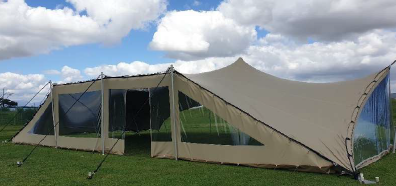What are Stretch Tents?
- richmondeventhire
.png/v1/fill/w_320,h_320/file.jpg)
- Mar 8
- 4 min read
It can be overwhelming finding the structure that's perfect for your event and it doesn't help if you don't understand the terms being used. In recent years, stretch tents have been gaining popularity, but few people truly understand their full potential for events. Here's a guide on the language of Stretch Tents and hopefully some answers to questions you may have been asking yourself.
So, let's start off with a pretty important one... What is a Stretch Tent?
This is a type of event structure that is made from flexible, 'stretchy' material that is designed to be tensioned over poles to create a dynamic covering. Perfect for all types of events including; weddings, parties, corporate events and festivals, stretch tents are becoming more and more popular as people get to know more about them. As well as looking sleek, stylish, fun (we could go on), they are also extremely durable. Made in South Africa, our stretch tents are made to endure a range of weather conditions. Fire retardment, waterproof and water repellent, UV-resistant are just some of the qualities that make our stretch tents a practical choice as well as a style choice.

The beauty of stretch tents is that they are vesatile, adapting to different environments, can be attached to buildings and can be put up in a range of different configurations, which leads us into our next set of questions. What do we mean by floating, corners down, sides down and windows/walls?
You'll see us using these terms when you are looking to hire a stretch tent to describe how you would like it to look and function. What sets stretch tents apart is their flexibility. The same tent can be configured in a number of ways and these are the names we give them. Find out what they actually look like below:
Floating
This is probably the configuration you have seen the most - at your local pub garden, as a covering for a wedding ceremony etc. When we talk about a floating stretch tent, we mean the tent material is floating above the ground with no sides down or no corners down. This tent is totally open.
Corners Down
To make a more dynamic look and provide a bit more shelter, you can also pin the corners of our stretch down to the ground. This can be done to all the corners or just a select number of them. This is makes a particularly distinctive look.

Sides Down
If you're looking for a more intimate space or looking for shelter from certain directions, you can pull a full side of a stretch tent down to the ground. This can be done for 1 - 3 sides. This does reduce the amount of usual standing space you have in the tent, if you decide to do this. But, it does create initimate spaces, whilst keeping the tent open.
Walls and Windows
You can now add windows and walls to our stretch tents. These allow extra shelter from the elements without having to reduce your space by bringing sides down.
Some other key terms that make up the stretch tent's structure and that you might see us using are below:
Poles
Poles are an integral part of the stretch tent's structure and cannot be changed. There a few different sizes and heights of poles involved in putting up a stretch tent. The differing heights are what helps manage any water running off the tent's roof. You have the king poles (approx. 4m high), which are the poles that are in the centre of the tent. These are the highest poles as they create the main room inside the tent. We then have side poles (approx. 3m high) and depending on how the tent is configured, corner poles (approx. 2m high). The corner poles are the lowest poles as they used to drain any water off the roof.
The number of poles depends on the size and type of stretch tent. You will find more information about our individual stretch tents through our catalogue page.
Guyropes
The size of our stretch tents is only part of the story. We'll need extra space around the tent to allow for our guyropes (usually around 2-3 metres on each side). The guyropes attach our outer poles to our stakes in the ground, making sure your tent stays secure.
On any sides or corner that are pulled down, these do not have guy ropes as they are pinned directly to the ground.
Stakes
You'll find we ask about what is going on under the ground where you want the stretch tent going up. That's because of our stakes. As with any outdoor structure (marquee, tipi, tent etc.), it will need to be staked to the ground to ensure it is secure and safe to use. That's why it's important for us to find out what is under the ground including any services (gas pipes, water pipes, electric cabling etc).
We do have other methods to grounding our stretch tents for terrain where staking is not possible, for example tarmac or patio. We can drill and fix, which involves drilling into the ground and repairing the hole when we take down the stretch tent. This is effective for tarmac and if there are larger gaps between stones in a patio. We can also weigh down the structure for where this is not possible.
Guttering
We can also link our stretch tents to make bigger structures. We can add a gutter to these linking sections to allow any rain to be drained away from tent. The gutter is basically another piece of our strecth tent material that attaches to each tent and connects the gap.
Not answered your question or would like a quote? Get in touch!


















































Comments